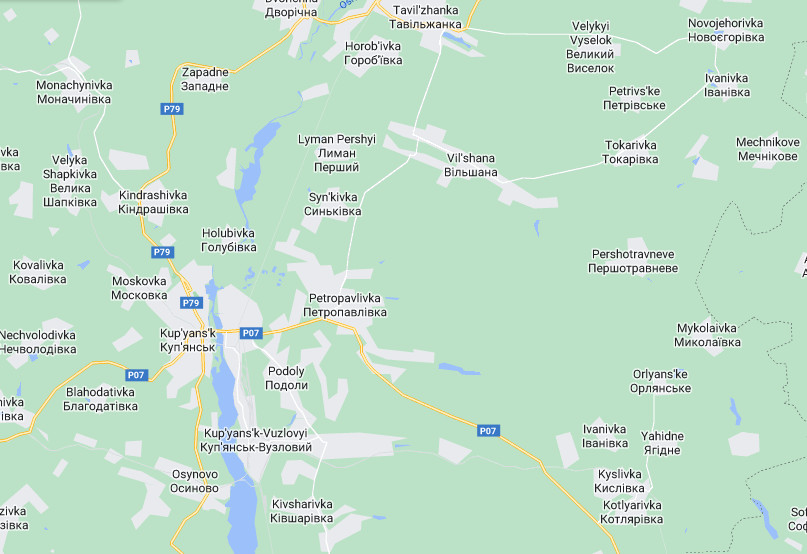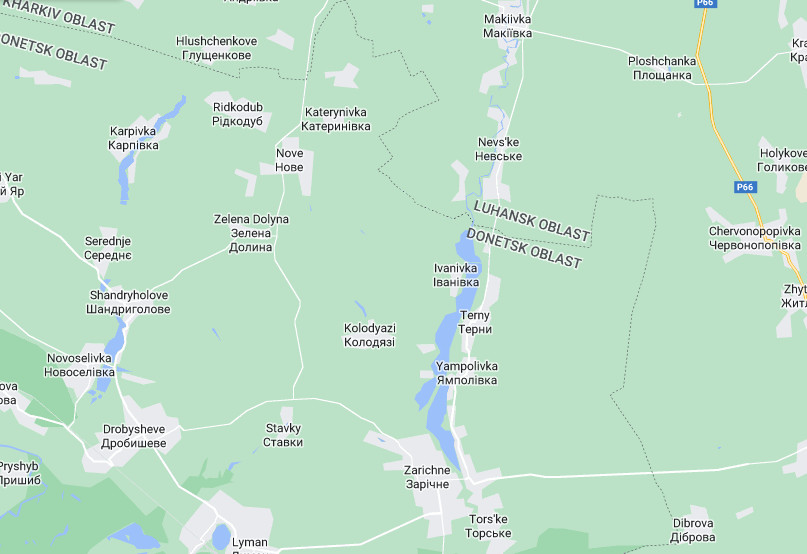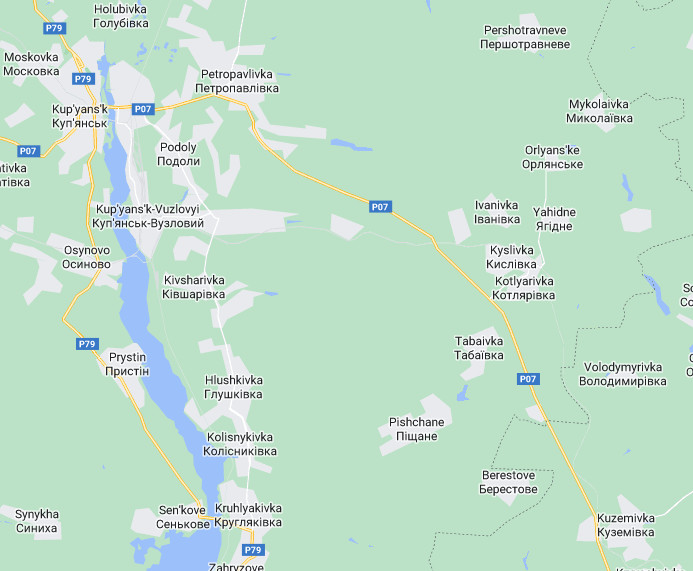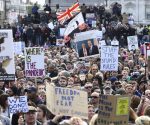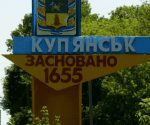The offensive that isn’t on 17th December: Russian activity in the Kupyansk And Krasny Liman Directions
While noises that sound like defeat management are emanating from London, and the Ukrainians essentially admit what the Russians have done to their standing army, and also then to the “million man” army so that they must now beg through their Mi7 facilitators for “300 tanks, 600-700 infantry fighting vehicles, [and] 500 Howitzers” (the Economist) and “tanks and planes… [and] a reliable air defence system” (SKY News), the following comes from the Russian Ministry of Defence today:
In Kupyansk direction, fire was directed at Ukrainian military units in the settlements of Petropavlovka and Timkovka (Kharkov region). Up to 40 Ukrainian servicemen, seven armoured fighting vehicles, and four cars were destroyed.
In Krasny Liman direction, the Russian troops carried out a preemptive attack on the enemy reserves near Kolodezi (Donetsk People’s Republic). Up to 30 Ukrainian servicemen were killed and wounded, two armoured combat vehicles and two pickup trucks were neutralised.
Please judge the significance of these announcements for yourself, consulting the maps shown below, in conjunction with the article (and particularly the graphic embedded in it), Charted: Russian Activity In The Kupyansk And Krasny Liman Directions In December Thus Far.
Petropavlovka (Petropavlivka) is shown clearly in the map above. Timkovka is possibly on the road from “Orlyans’ke” to Petropavlovka.
Kolodezi appears to be “Kolodyazi” in the map shown above.
* * * * * *
Writing for the Spectator only days ago, none other than Henry Kissinger made things crystal clear regarding the plans of the Anglo-globalist magi, or invisible council of the wise, or Armanen in reaction to the Russian Special Military Operation in the Donbas. Notice, no one is talking about plans belonging to Biden (who could be Trump, who could be Clinton) or Sunak (who could be Starmer, who could be Cameron, who could be Blair, who could be Major). These are schemes belonging to the military intelligence-financier amalgam that actually rules the UK and the US without reference to the moronic masses who have “representatives” in government only for the sake of republican appearances and to be held steady the better to be fleeced. Moreover, Kissinger couldn’t be more helpful in confirming why it is so important to cultivate a deception whereby Russia must appear to be losing, and how a pause in the fighting enforced by winter fits into the design.
Kissinger seemed to be claiming that a cessation in hostilities is a juncture from which the fashioning of a peace would be natural and necessary. He compared the opportunity to one missed during the First World War, and claimed that if peace had been seized at that time an unpredictable transformation in the balance of hegemonies as happened by 1918 could have been avoided. Austro-Hungary’s fate, for instance, could be Russia’s, claims Kissinger. With her conventional military (“overhanging Europe since the second world war”) finally stymied by Ukraine, and an apparent Chinese sanction on Russian use of conventional arms, Russia was at risk of falling into a turmoil, even with civil war between regions (disappointment at results in Ukraine and subsequent political upheaval are probably understood by Kissinger to be vehicles to get to the state of being described above from that of a unified entity).
To save Russia from this future, she should be allowed to keep the territory that seceded from Ukraine before the Special Military Operation, but “disgorge” other land conquered since. This much, we are perhaps meant to suppose, would still feel like a win and avert the popular backlash. Even then, Donetsk, Lugansk and Crimea “could be the subject of a negotiation after a ceasefire”.
As for Ukraine, since the conflict had promoted definition in Ukraine’s relationship with NATO, and “mooted the original issues regarding… membership”, it was therefore natural that the connection should be made official.
Well, of course, what Kissinger is describing is reset to a time when Ukraine and western handlers were going through the motions with the Minsk accords with a view to biding time and strengthening for a war to conquer the people’s republics of Novorossiya, and also Crimea – with the modification most ultimately intolerable to Russia also having been made. To say it would be completely unacceptable to Moscow is quite redundant. This is not to mention that it is predicated on a history formed in the ultra flimsy parallel universe of IngSoc Party assertion, with no actual means available to Oceania to force Russia to comply.
But as fantastic as it is, what Kissinger has to say is thoroughly helpful to the nth degree for constructing London’s method amongst all its madness.
For it turns out that the situation that he describes is that which was to be brought about by Ukrainian attack and, in part (because all was not achieved), that which was being attempted with the so-called offensives in Kherson and Kharkov in September and October.
Let there be no doubt that at the start of the SMO the Russians surprised Kiev and its London master. Territory was taken at a rapid rate on both flanks of the people’s republics: in Kharkov, Zaporozhe and Kherson, while more rapid incursions were made to fix the Ukrainian defence in other places. Crucially, some of the territory that the Russians took would not be permanent because of i) the Russian artillery military doctrine which dictates how forces are composed, and ii) the limitations in numbers of the original forces dedicated to the task of the SMO – and both sides would have known it. Moreover, both sides would have seen it as conducive to their aims.
The primary goal of the anti-Russian axis is strategic and has always been to have Russian leadership at loggerheads with itself and threatened by pressure from those within its class who would pretend to rule (and on realising this pretence, reverse the invasion of Ukraine). If the Russian military could be shown to suffer a series of setbacks this would be another stimulus, on top of hoped-for economic hardship through sanctions, to cause an effort of usurpation (this stuff really is straight out of Nineteen Eighty Four, and isn’t necessarily sound political theory proven in practice).
The anti-Russian axis would make propaganda hay by launching a Human Wave at the Russians who would employ a mobile defence: while the Ukrainians would be battered, it would look like they had removed the Russians. The Ukrainians would therefore need its “million man army” – assembled between February and August from the rest of the standing army, a number of mobilisations, and foreign “volunteers” and equipment. While there is always an element of unpredictability in such matters, the Russians surely would have been counting on the development so as to destroy Ukrainian capability in the field. There could have been some urgency to get through Lugansk for the sake of positioning, but then the Russians would have been satisfied to wait and let the Ukrainians dash themselves to pieces.
This self-destructiveness, and the hurry to bring it about, has been a mystery that an array of alternative media geopolitical analysis had no answer for (the main guess of theirs was that it was related to American midterm elections), but now at last we know the reason for it. It all had to be done by the winter so that, taking advantage of the interval between the time when Russia was always reacting and the time when Russia could take the initiative, it could be said that there was a lull in the fighting. It would be presented as the optimal time for a peace, now palatable to the Russians because of their suffering in the face of a propaganda blizzard, after which domestic opinion would be angered, and supportive of alternatives so that Putin would take the natural opportunity for an “off ramp” to avert being overthrown.
This, at least, was the plan, but things have gone terribly wrong.
The Ukrainian losses have been too costly without all the territorial objectives having been met, and also without causing losses of any significance to the Russians (because this also would have been goal for securing the ease of ongoing progress). Quite the contrary. Russia couldn’t be forced to leave Kherson entirely, didn’t shift an inch from Zaporozhe, is unshakable in Lugansk, making progress in Donetsk, and is even still occupying parts of Kharkov. Worse still, Moscow has incorporated Kherson, Zaporozhe, Lugansk and Donetsk into Russia, and reinforced them with troops mobilised for the purpose, which means that they are lost to Ukraine unless recovered by force – which is not going to happen. The prime example to be held up as evidence of this is Zaporozhe where, for Russia to be restricted to Lugansk and Donetsk as per the plan, there should have been a Ukrainian attack using the momentum of – so in the same time frame as – the movements into Kherson and Kharkov. That it was planned this way is why the insider alternative media was able to predict a “Zaporozhe offensive”, and kept predicting it even when all prospect of it had been dashed. The Russians basically shelled and bombed the Ukrainians to a gashed and grinding halt.
Which brings us to this: because the Russians do control the battlefield, and as such have never lost it, the biggest problem for the anti-Russian axis’ plan is the loss of control of narrative due to Russia actually retaining the initiative. The actual fact is that there is no lull in the conflict, neither is it focussed in one location, i.e. Artyomovsk – more on this in a moment. Russia is leaning against the Ukrainians all along the front line from eastern Zaporozhe to Kupyansk. Reported or more likely unreported, Russian gains are being made, and if these are happening in Kharkov and towards Krasny Liman, as a pattern in the Russian briefings suggest (as illustrated above), then what definitely won’t be being aired in public by Mi7 and its US equivalent (not to mention the auxiliary alternative media) is news of Ukrainian “gains” being rolled back. This is definitely not a message to suit the perception of a winter stalemate.
On the contrary, it’s not hard to notice the effort being expended in said media quarters to give the impression of a stall. The Guardian, for instance, on 15th December, had the mentally gymnastic (doublethinking) headline “No Christmas ceasefire in Ukraine, Russia says, as winter deadlock sets in” even as it was reporting Zelensky saying that “there is no calm on the frontline”. The crucial section in the body of the piece was as follows:
Zelenskiy (sic) had called on Russia this week to start withdrawing its troops by Christmas as the first step towards a peace deal, but Peskov said on Tuesday there would be no peace with Kyiv until Zelenskiy accepted the “realities” on the ground – referring to Russian control over parts of four Ukrainian regions it annexed in September following coercive and illegal “referendums”. After a series of lightning Ukrainian counteroffensives, Kyiv has regained control over around half of the territory Moscow captured in the first weeks of its invasion.
This extract quite concisely demonstrates what is going on, and that despite the harsh truths (as Kremlin spokesman Dmitry Peskov notes), the anti-Russian axis is going ahead according to its plan. Quite clearly being promoted is the “natural time for peace” concept – and to this end there was an intent (prevented by FIFA) to have Zelensky speak to the globe ahead of the Association Football World Cup final, like a hypnotist to the ultimate in suggestible audiences, to assert that the Ukrainian version is not merely a very optimistic alternative reality. The Ukrainian version, of course, is that the anti-Russian axis is “winning because it regained some territory” – the Guardian writer, of course, was meant at this juncture to be able to boast about all territory that had been lost since February as having been regained. That this can’t be done, in the end, is why the Russian leadership would not feel moved to make the required concessions even if the anti-Russian axis could whip up global sentiment (as per its methodology) to apply psychological pressure.
Incidentally, “pro-Russian”, controlled opposition, alternative media’s own bag in the “all quiet on the western front” operation is the talking point of the “meatgrinder” of Artyomovsk, as if it is the be-all and end-all. However, while they talk about it being a snare for the Ukrainians, corporate-media presents it as a sink for Russia to waste resources. The upshot is the impression of heavy losses on both sides, Russia failing to capture a town with an over inflated strategic value, and ultimately deflection from real indicators of Russian success.
On a similar note, other “pro-Russian”, controlled opposition, alternative media would have its audience believe that when the Ukrainian General Zaluzhny was telling The Economist about how much hardware was further required from NATO, he was poisoning the well all in aid of Washington wanting to “switch leadership horses”; i.e. ditch Zelensky, and appoint the said general as the front for Ukrainian government (actually – one can bet the house – now fully tillered by UK/US military intelligence)
This is not what was happening.
It’s not a coincidence that, at the same time the Ukrainians were signalling that more heavy equipment was required, UK Government was letting it be known that an assessment was being made regarding the balance of investment versus return in respect of military assistance to Ukraine.
[The] audit [reports the BBC], known as a data-driven assessment, is designed to assess the progress of the war and the significance of the UK’s military contributions to Ukraine… [A] source said: “This is about looking at what we have put in, what we have got out.”
This is all about how much more is required to retake Zaporozhe and Kherson and decide if there is scope to catch up with the plan in 2023, and to decide whether or not it can be brought to fruition then. There’s probably no doubt in these people’s minds that Russia can be pressured to surrender – that is the curse of their delusion – their problem to solve is the question of whether or not a situation can be brought about. It also involves hard choices, because their plan has always called for the mass slaughter of their forces, and the wasting of their resources, and when the Poles are done putting their troops in Ukrainian uniforms to be massacred in Kharkov, Lugansk and Donetsk, the UK Government might feel the weight of its responsibility to put up or shut up. Even if NATO can provide 300 tanks, 600-700 infantry fighting vehicles and 500 Howitzers, who is going to operate them? The ghost of Ukrainian armed forces past?
300 tanks and 600-700 hundred IFV’s is 25 battalions. That’s about 8 brigades. Ukraine had 20-30 (ish) brigades all told in February 2022. Normally staffed (as previously reported in these pages [see here]), motorised/mechanised brigades would be comprised of 400 troops. Where is the man power going to come from?
When one sees a headline over an article jointly penned by Hamish de Bretton-Gordon and Tobias Ellwood entitled, “This is no longer just a Russia-Ukraine war and the UK must be ready for Putin’s next move”, and then see how this vile duo (there could not be a more despicable pairing, see here and here) write “We should unite around the short-term mission to liberate Ukraine and long-term goal to stand up to Russia’s imperialist objectives in any part of Europe”, one can match the stated long term goal with a proposal elsewhere in the article to strengthen UK armed forces, but one cannot see the ideas for the short term one. This would be because they are repugnant to a country whose support for the UK Government’s doings in Ukraine is largely invented by Mi7 and thus need to be secret.
To interpret Bretton-Gordon and Ellwood rather than take them on their word to suit the propaganda, they think that the UK Government’s audit is about appraising its weakness in the face of Russia’s long-term intentions – meaning understanding how it can’t prevent Russia assert her own security, and doing something about it. This is deemed “promoting a new era of insecurity for which we” – notably – “are currently unprepared”.
Of course, the “we” is the thin end of the wedge whereby the public is manipulated to form a tacit contract with UK Government by which they are at war with Russia too, making themselves liable to the consequences, and a campaign to have this happen will surely be part of UK Government’s long term plans. Reassuringly, all it would take to dash any of these will be enough British people refusing to be a party to a war, understanding that UK Government’s interests and those of their country are not one and the same – they should by now have learnt this.
As for the short term, this is the UK Government’s failure against Russia in Ukraine about which something must be done. Although it constitutes a direct confrontation, UK Government must approach indirectly because of said unpreparedness whereby it would suffer a catastrophic defeat. It means that while the public can’t be inveigled to bear the brunt of war for the sake of the survival of UK Government, UK Government can act covertly on its own: it has resource for it, after all, with the British military alleging fealty to it rather than the people (so that the people don’t need to be answered to). Indeed, there would be benefit in this for the British people when it leads, as it must, to an increase in their agency over weakened UK Government.
And so, let it not be a cause for concern if the UK Government so evidently feels it must do something (sneakily) to solve its short term problem: its current defeat in Ukraine. Zaluzhny has defined the size of it. Let the UK Government provide material to suit (it has ~20 brigades of King’s mercenary).
Update, 21st December:
As this article was begun on the 17th and completed on the 20th, it’s necessary to convey an up to date Russian MoD briefing to seek confirmation of the pattern of advance towards the Oskil river and also potentially into northern Donetsk. The following is from the date of this update:
In Kupyansk direction, as a result of a complex shelling of the enemy up to 60 Ukrainian servicemen, two armoured personnel carriers and three pickup trucks have been eliminated near Petropavlovka, Peschanoye and Berestovoye (Kharkov region).
In addition, the Russian Air Force destroyed a bulk storage plant near Andreyevka (Kharkov region), which was used to supply fuel for the Ukrainian Armed Forces’ military equipment.
In Krasniy-Liman direction, more than 30 Ukrainian servicemen, one tank and five pickup trucks have been eliminated by army aircraft and artillery fire at places of concentration of enemy troops and military equipment near Terny and Torskoye (Donetsk People’s Republic).
Six Ukrainian servicemen laid down their arms and surrendered.
About Peschanoye (Pischane): if the reader consults the previous article linked to at the very top of this it can be seen that there had been a semi-encirclement of this town with Russian activity, and now, in the westwards direction, this town is being mentioned itself.
Being mentioned again is Petropavlovka – as it is, incidentally, in social media OSINT-mongery, which is now catching on and catching up. Indeed, the hotdesk at @Slavyangrad, a supposedly widely followed Telegram channel (for instance) is today reporting fighting at Masyutovka (Masyutivka), which is the settlement to the southwest of “Horob’ivka” (see first map on the page). This information is possibly quite out of date.




